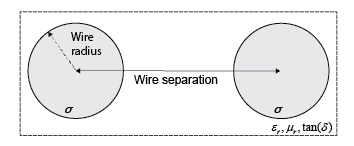txlineTwoWire
Create two-wire transmission line
Description
Use the txlineTwoWire object to create a two-wire transmission
line. A cross-section of a two-wire transmission line is shown in this figure. The physical
characteristics of a two-wire transmission line include the radii of the conducting wires, the
separation or physical distance between the wire centers, and the relative permittivity and
permeability of the wires. RF Toolbox™ software assumes that the relative permittivity and permeability are
uniform.

Creation
Description
twowiretxline = txlineTwoWire
twowiretxline = txlineTwoWire(Name,Value)txline =
txlineTwoWire('Separation',0.0046) creates a two-wire transmission line with
a dielectric thickness of 0.0046 meters.
Properties
Object Functions
sparameters | Calculate S-parameters for RF data, network, circuit, and matching network objects |
groupdelay | Group delay of S-parameter object or RF filter object or RF Toolbox circuit object |
noisefigure | Calculate noise figure of transmission lines, series RLC, and shunt RLC circuits |
getZ0 | Calculate characteristic impedance with and without dispersion for transmission line |
circuit | Circuit object |
clone | Create copy of existing circuit element or circuit object |